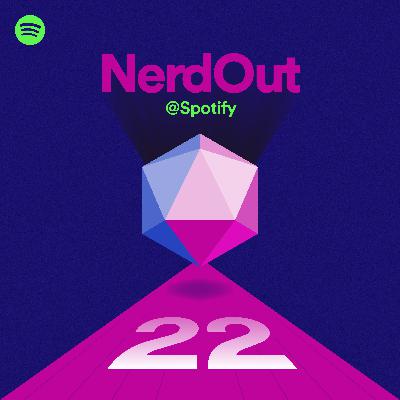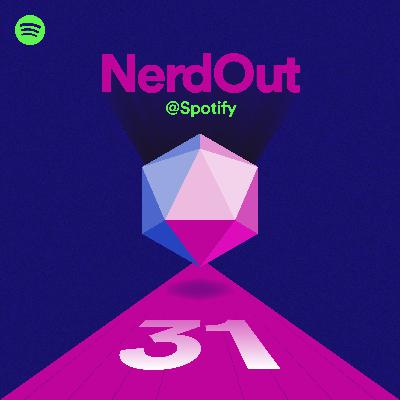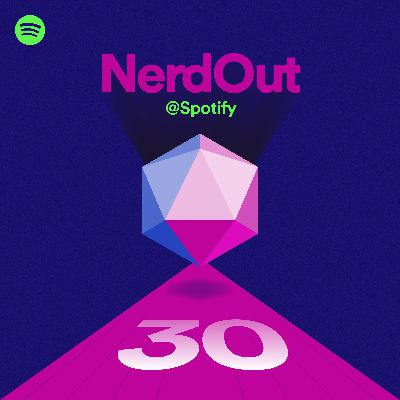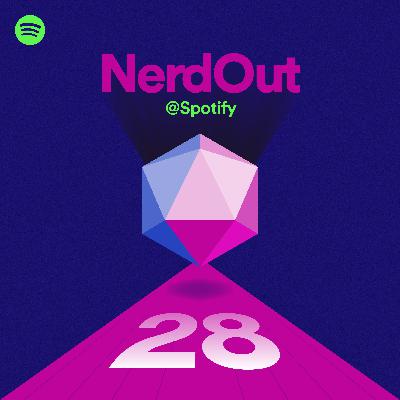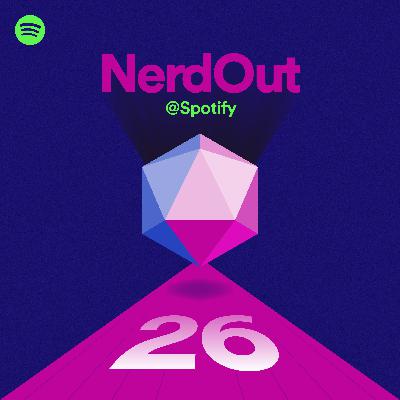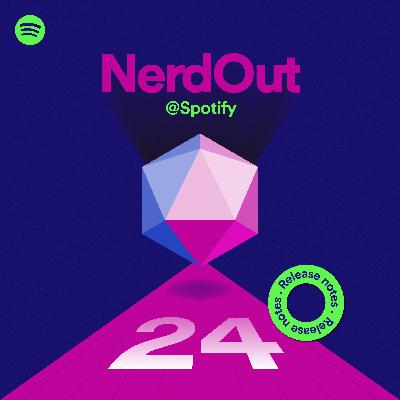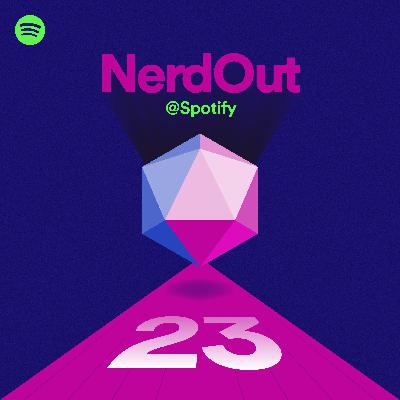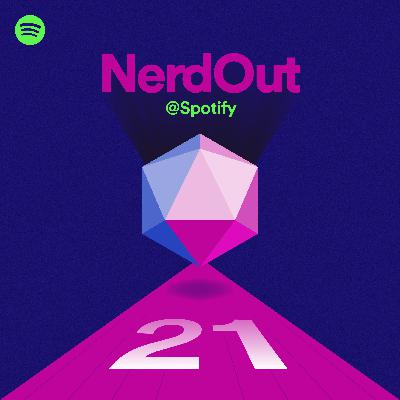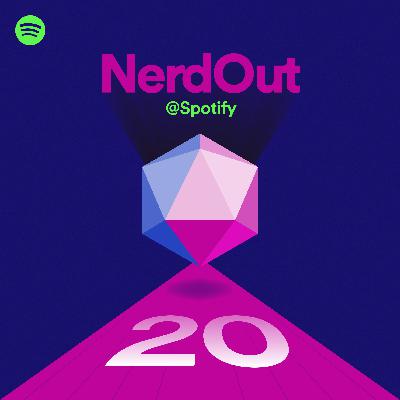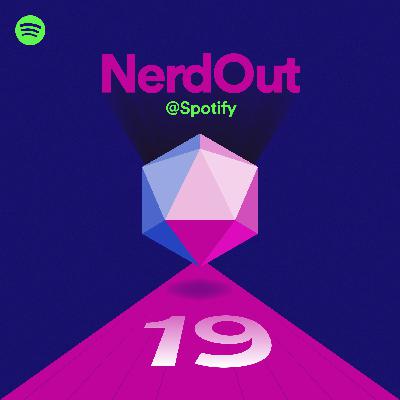Discover NerdOut@Spotify
NerdOut@Spotify

NerdOut@Spotify
Author: Spotify R&D
Subscribed: 23Played: 335Subscribe
Share
© Spotify R&D
Description
NerdOut@Spotify is a technology podcast produced by the nerds at Spotify and made for the nerd inside all of us. Hear from Spotify engineers about challenging tech problems and get a firsthand look into what we're doing, what we're building, and what we’re nerding out about at Spotify every day.
34 Episodes
Reverse
In the very old days, if you needed more storage for your database, you had to walk into the data center and install another server. Now you can just log into your cloud provider’s console and click a few buttons. Voilá, more storage. So easy! But what if you’re replicating that storage configuration for hundreds of databases at once? Suddenly, that’s a lot more clicking. Not so easy! (Plus, very tedious and very error prone.) So instead of living with this “ClickOps” approach, we developed a declarative infrastructure model — our very own “infrastructure as code” solution for managing cloud resources at Spotify scale. Instead of manually configuring each resource, developers just describe the state they want. And once we adopted declarative infra, we unlocked ways to improve not just how we manage resources, but also how we update policies, manage dependencies, and make other changes to code across our entire fleet of repos — quickly, safely, easily. In other words, programmatically.
Host Dave Zolotusky talks with David Flemström — who went from pushing the limits of Spotify’s infrastructure as a feature developer to working on the platform team in order to improve infrastructure for all of our developers. The two Daves discuss what declarative infrastructure means at Spotify, our journey to adopting it (going from Puppet to cloud consoles, to something better than both) and why we did it, how our model works (Kubernetes!), how it changed the relationship between our feature teams and our platform teams, how this shift helped enable Fleet Management at Spotify, and where we’re going next with abstracting infrastructure so that it helps our engineers do more, more easily.
Learn more about declarative infrastructure and Fleet Management: NerdOut, Episode 12: Fleet First
Fleet Management at Spotify (Part 1): Spotify’s Shift to a Fleet-First Mindset
Fleet Management at Spotify (Part 2): The Path to Declarative Infrastructure
Fleet Management at Spotify (Part 3): Fleet-wide Refactoring
Read what else we’re nerding out about on the Spotify Engineering Blog: engineering.atspotify.com
You should follow us on Twitter @SpotifyEng and on LinkedIn!
Spotify is in the middle of a big shift in modern computing: moving from x86 processors to Google’s new ARM-based Axion chips. This isn’t just a hardware swap — it’s a disruptive change with ripple effects across performance, efficiency, and sustainability.In this episode, we sit down with Mo Farhat, Group Product Manager for Google Compute Engine, to unpack what makes ARM so game-changing in the data center. From the history of ARM’s rise, to the challenges of designing chips for hyperscale workloads, to why this transition matters for the future of cloud computing, Mo offers a look inside how Axion was built and why now is the tipping point for ARM.If you’ve ever wondered what really powers the services you use every day — and why Spotify is betting on Axion — this is the episode to listen to.Learn more about Google Axion Processors: Leading processors custom-built for cloud workloadsIntroducing Google Axion Processors, our new Arm-based CPUsC4A VMs now GA: Our first custom Arm-based Axion CPUAxion in action: Unlock price-performance and efficiency with Google Axion VMsThe Impact of Google Cloud’s Arm-Based Axion Chip: ExplainedRead what else we’re nerding out about on the Spotify Engineering Blog: engineering.atspotify.comYou should follow us on Twitter @SpotifyEng, LinkedIn, and YouTube!
Hear about the journey behind building Spotify’s AI knowledge assistant, aka AiKA — from hack projects to internal chatbot, to enterprise developer tool.While general purpose chatbots are being used everywhere, they often fall short when it comes to navigating company-specific information — like which internal policy applies to your team or where to find the doc someone shared in Slack three months ago. That’s why we built AiKA. Using retrieval-augmented generation (RAG), AiKA taps into Spotify’s internal knowledge sources to provide employees with context-aware answers right when they need them.Host and principal engineer Dave Zolotusky is joined by senior engineers Majd Salman and Jofre Mateu to discuss AiKA’s evolution from a bunch of hack week experiments to a unified chatbot platform now used weekly by 25% of Spotify’s employees and 87% of our developers. They share why RAG is the right approach for making an internal chatbot accurate and fast, how AiKA has cut the time it takes to resolve internal support requests by 47%, and how we’re extending AiKA’s agentic capabilities with MCP.🤖 Want to see how AiKA can supercharge knowledge sharing where you work? Sign up to try Spotify Portal for Backstage at: https://backstage.spotify.com/try-portal/ Learn more about Spotify’s AI knowledge assistant:Our KubeCon talk: Leveraging Internal Knowledge: Building AiKA at SpotifyThe New Stack: Introducing AiKA: Backstage Portal AI Knowledge AssistantTechCrunch: Backstage access: Spotify’s dev tools side-hustle is growing legsSpotify’s Backstage Blog: AI knowledge assistant and data plugins coming to Spotify PortalRead what else we’re nerding out about on the Spotify Engineering Blog: engineering.atspotify.comYou should follow us on Twitter @SpotifyEng, LinkedIn, and YouTube!
Last year Spotify launched a big update to the app: a new typeface. For most of us, changing fonts is easy. It’s just a dropdown menu away. But creating a whole new typeface and then rolling it out across 45 unique platforms, and over 2,000 types of devices spread across 200 brands – that’s not so simple. This brand new font is called Spotify Mix and it was made just for Spotify. From playlists to microsites and billboards, it’s what you’ll see everywhere you see Spotify, representing the brand’s distinctive voice. In this episode, we’ll get into the technical and aesthetic challenges that go into creating and deploying a new typeface as well as what made its release possible: Spotify’s internal design system, known as Encore. Host and principal engineer Dave Zolotusky speaks with two people on Spotify’s design platform team who helped bring Spotify Mix to the world: an iOS engineer and “Spotify’s one and only typographer” — a designer who specializes in type and fonts.Learn more about Spotify Mix and our internal design system, Encore:Introducing Spotify Mix, Our New and Exclusive Font — SpotifyCreating coherence: How Spotify’s design system goes beyond platforms — FigmaDesign Systems Podcast, Ep. 84: Digital typography: Suggesting, not dictatingRead what else we’re nerding out about on the Spotify Engineering Blog: engineering.atspotify.comYou should follow us on Twitter @SpotifyEng, LinkedIn, and YouTube!
Ever heard of Kubernetes? Envoy? Prometheus? You probably have. But what you may not know is that these projects are managed and sustained by the Cloud Native Computing Foundation, aka the CNCF. Cloud native computing allows IT and software to move faster, and open source projects are essential to furthering these innovations and keeping them accessible for everyone. The CNCF is dedicated to fostering and sustaining an ecosystem of open source, vendor-neutral projects. In fact, Spotify donated Backstage to the CNCF in September 2020 and it moved to incubating maturity level March 2022. To celebrate the CNCF’s 10th year, host and principal engineer Dave Zolotusky speaks with Chris Aniszczyk, Chief Technology Officer at the CNCF to better understand what an open source foundation is, what it does, and why it matters so much to the developer community. Plus, we’ll get a sneak peek at KubeCon + CloudNativeCon Europe.Learn more about Chris Aniszczyk, the CNCF, and open source:NerdOut@Spotify, Ep.02: Open IssuesNerdOut@Spotify, Ep.11: Open Source Work Is WorkCloud Native Computing Foundation blogChris Aniszczyk on TwitterChris's Open Source Velocity ReportsCertified Backstage Associate certification and other certificationsRegister for KubeCon + CloudNativeCon LondonRead what else we’re nerding out about on the Spotify Engineering Blog: engineering.atspotify.comYou should follow us on Twitter @SpotifyEng, LinkedIn, and YouTube!
How did we learn to do event delivery at scale at Spotify? It’s been a journey. When you do something like tap the play button in the Spotify app, that’s an event. And getting that event data is fundamental to the Spotify experience. Without it, we wouldn’t be able to make music recommendations, pay artists fairly, or track down pesky, hard-to-find bugs. At the most basic level, this seems like a straightforward process: record an event, send that event data to a server somewhere, do something useful with it. Easy, right? But now, multiply that process by 50 million events per second. So, how do we make sure all that important data is delivered reliably, from our client apps to the cloud?
Host and principal engineer Dave Zolotusky talks with 9-year Spotify veteran Riccardo Petrocco about our journey building a event delivery system that can reliably handle a trillion events around the world, moving from Kafka to the cloud, building systems that are simple enough so that nobody tries to find a way around them and encourages “doing the right thing”, the definition of “quality data”, the value of moving up the stack and focusing less on the data pipes and more on what’s in them, and how Backstage makes it easier for our developers to discover, consume, produce, and manage data.
Learn more about Spotify’s data journey:
NerdOut@Spotify, Ep.09: It’s All About the Data
Data stories on the Spotify Engineering Blog
Read what else we’re nerding out about on the Spotify Engineering Blog: engineering.atspotify.com
You should follow us on Twitter @SpotifyEng, LinkedIn, and YouTube!
We’ve seen generative AI and large language models do some amazing things in the past year — but how do you go from a tech demo to a real shipping product? In this Release Notes episode of the NerdOut@Spotify podcast, we’ll hear about what it took to ship our Voice Translation pilot, which takes podcasts recorded in English and uses AI to generate the original podcaster’s voice speaking in Spanish (with German and French coming next).
Host Dave Zolotusky talks with senior machine learning engineering manager Sandeep Ghael about how we brought expertise from across the company in order to go from a weekend prototype to releasing fully translated episodes of Lex Fridman, Armchair Expert, and other podcasts — in just six weeks.
Read more about Voice Translation for podcasts:
Spotify’s AI Voice Translation Pilot Means Your Favorite Podcasters Might Be Heard in Your Native Language
Hear the results on Spotify:
Lex Fridman Podcast — “Interview with Yuval Noah Harari”
Armchair Expert — “Kristen Bell, by the grace of god, returns”
The Diary of a CEO with Steven Bartlett — “Interview with Dr. Mindy Pelz”
More episodes on the Voice Translation Hub
Read what else we’re nerding out about on the Spotify Engineering Blog: engineering.atspotify.com
You should follow us on Twitter @SpotifyEng and on LinkedIn!
Over the summer, Spotify helped Tesla engineers ship a major update to their built-in media player. In this Release Notes episode, host Dave Zolotusky talks with Spotify engineering manager Geetika Arora and senior product designer JC Chhim about collaborating with Tesla to improve the in-car listening experience, the value of having a familiar user experience across devices, and how there’s more to a great collaboration than just picking the right SDK for the job.
Introducing Release Notes — a new series of mini episodes on the NerdOut@Spotify podcast. There are hundreds of teams at Spotify working on so many different things — from playlists that change throughout the day, to realistic voice translations, to a smarter way to shuffle songs. In each episode of Release Notes, we focus on one thing we shipped and what went into building it. You’ll see these mini episodes from time to time in the main podcast feed right alongside our regular episodes.
Learn more about our SDKs on the Spotify for Developers site: developer.spotify.com
Read what else we’re nerding out about on the Spotify Engineering Blog: engineering.atspotify.com
You should follow us on Twitter @SpotifyEng and on LinkedIn!
How do you get a machine to find a song that’s similar to another song? What properties of the song should it look for? And then does it just compare each track to every other track, one by one, until it finds the closest match? When you have a catalog of 100 million different music tracks, like we do at Spotify, that would take a long time. So, for these kinds of problems, we use a technique known as nearest neighbor search (NNS). This past summer at Spotify, we built a new library for nearest neighbor search: It’s called Voyager — and we open sourced it.
Host and principal engineer Dave Zolotusky talks with Peter Sobot and Mark Koh, two of the machine learning engineers who developed Voyager. They discuss using nearest neighbor search for recommendations and personalization, how to go from searching for vectors in a 2D space to searching for them in a space with thousands of dimensions, the relative funkiness and danceability of Mozart and Bach, how to find a place on a map when you don’t have the exact coordinates, tricky acronyms (Annoy: “Approximate Nearest Neighbor Oh Yeah”) and initialisms (HNSW: “Hierarchical Navigable Small World”), why we stopped using our old NNS library, why we open sourced the new one, how it works for use cases beyond music (like LLMs), and looking for ducks in grass.
Learn more about Spotify Voyager:
About Voyager
Voyager on GitHub
Voyager documentation for Python
Voyager documentation for Java
Read what else we’re nerding out about on the Spotify Engineering Blog: engineering.atspotify.comYou should follow us on Twitter @SpotifyEng and on LinkedIn!
Last episode, we talked about ABBA, our first A/B testing tool. We used it to test UI changes, new features, content recommendations — anything and everything we could think of. ABBA was so good and worked so well for so long…that we decided to get rid of it. Years of using ABBA taught us what makes for good experimentation, and we eventually realized we needed a better tool, built from scratch. Listen to find out why we pulled the plug on ABBA and how Spotify’s Experimentation Platform was born. And in case you missed it, a version of our internal platform will be available to the public as Confidence, a new enterprise product for developer teams — read today’s announcement: “Coming Soon: Confidence — An Experimentation Platform from Spotify”.
But first, let’s talk buttons. Everyone always has so many questions about buttons. How do you know which color they should be? Or how big they should be? Or whether the corners should be round or square? The easy answer: an A/B test! But if only all product experimentation was as simple as testing buttons. Senior staff engineer Mark Grey returns to talk with host Dave Zolotusky, along with senior engineer Dima Kunin — he helped build Spotify’s Experimentation Platform and was the guy who had the honor of finally retiring ABBA. They discuss the ins and outs of enabling experimentation at scale, including targeting criteria, controlling eligibility, the importance of measuring exposure, using properties instead of feature flags, the advantages of separating your app configuration from your experiments, fallback states, sample ratio mismatches — and all the other questions you have to answer about your experimentation process before you can even ask something as simple as “what color should a button be” — let alone “will this machine learning model consistently provide recommendations users appreciate over the next year”.
Plus, did you definitely, positively, absolutely eat the bread? Or did you just buy the bread? And a bonus trick question: What’s the difference between “treatments”, “variants”, and “groups” — and why is it always so hard to name things?
Learn more about ABBA and its successor, Spotify’s Experimentation Platform:
20: The Rise and Fall of ABBA: Listen to our previous episode with Mark Grey talking about our very first A/B testing tool, ABBA.
Spotify’s New Experimentation Platform (Part 1): How we went from ABBA to building EP, the internal experimentation platform we use today and that Confidence is based on.
Spotify’s New Experimentation Platform (Part 2): More features of EP, including our custom “salt machine” and more.
Plus, find out lots more about how we do experimentation at Spotify on our engineering blog — including a little light reading on automated salting and bucket reuse, choosing sequential testing frameworks, comparing quantiles at scale, and how we scale other scientific best practices across the org.
Read what else we’re nerding out about on the Spotify Engineering Blog: engineering.atspotify.com
You should follow us on Twitter @SpotifyEng and on LinkedIn!
Back in the day, Spotify built a custom A/B testing tool called ABBA. It was great. The platform enabled lots of teams to try out lots of ideas for new features to see what worked and what didn’t. With ABBA, we went from doing tens of experiments to hundreds of experiments. But we didn’t just learn what color button users liked better: the more tests we ran, the more we learned about our testing methods, including the limitations of ABBA itself — which eventually led us to a new, better way to test. Here’s the story of ABBA, our very first experimentation platform, and the lessons we learned about doing product experimentation at scale.
Host Dave Zolotusky talks with Mark Grey, a senior staff engineer and 10-year Spotify veteran. They discuss Spotify’s earliest efforts at product testing, our early infrastructure for data and data processing (using Hive and Hadoop), how migrating to the cloud unlocked more processing power (and more testing), the difference between using tests to design the color of a button and using tests to inform the very next user interaction via machine learning, feature flags and holdout groups, all the things we learned about conducting scientifically sound experiments, how we built a culture of experimentation among our software development teams, and what finally drove us to sunset ABBA and build its successor: a bigger, better internal experimentation platform. Plus, progress bars and lightsabers.
Read more about ABBA and how we do product experimentation at Spotify:
Spotify’s New Experimentation Platform (Part 1)
Spotify’s New Experimentation Platform (Part 2)
Search Journey Towards Better Experimentation Practices
Spotify’s New Experimentation Coordination Strategy
Choosing a Sequential Testing Framework — Comparisons and Discussions
Comparing Quantiles at Scale in Online A/B-Testing
Read what else we’re nerding out about on the Spotify Engineering Blog: engineering.atspotify.com
You should follow us on Twitter @SpotifyEng and on LinkedIn!
We’re often focused on features that improve the experience for users — letting them do something better, faster, smarter. But if you don’t consider accessibility issues, many users won’t be able to use the feature at all. From color contrast and text size to alt text for enabling screen readers and voice commands, accessibility issues can affect everyone, whether you have a permanent disability or just an armful of groceries. So how do you get developers and designers to adopt an accessibility mindset and make it a fundamental part of the development process?
Host Dave Zolotusky talks with Dani Devesa Derksen-Staats, an iOS engineer on Spotify’s accessibility team. We’ll hear how Dani went from a five-year computer science program, where accessibility wasn’t mentioned even once, to becoming so passionate about the topic, he wrote a book on it. They also talk about the basic things we forget to consider when we don’t consider accessibility; how we can all benefit from accessibility improvements, whether that’s getting up a curb in a wheelchair or while pushing a stroller; and ways to address accessibility issues into the development process, from adopting a multimodal approach to UX design to integrating accessibility tests into your CI/CD.
Spotify recently introduced an Accessibility Center. Have questions or concerns about accessibility? Contact us:
Email: accessibility@spotify.com
Write to us at: Spotify USA Inc., 150 Greenwich Street, Floor 62, New York, NY 10007, USA
More on accessibility from Dani:
His book: Developing Accessible iOS Apps (GitHub)
His 2023 talk for Accessibility NYC: Creating Accessible iOS Apps: An Action Plan
His 2022 talk at NSSpain X: 365 Days of Accessibility
Read what else we’re nerding out about on the Spotify Engineering Blog: engineering.atspotify.com
You should follow us on Twitter @SpotifyEng and on LinkedIn!
How do you make an AI-generated voice feel more like a real person? You give it a real personality. Spotify recently released a new feature in the US and Canada called DJ. Turn it on, and you hear a curated selection of music and recommendations, along with a fun, friendly, knowledgeable voice telling you more about what you’re listening to (you know, like a real DJ) — except everything you hear is personalized just for you. Learn what makes this DJ feel so realistic and meet the people behind the technology — including the DJ himself.
Host Dave Zolotusky talks with product director Zeena Qureshi and director of engineering John Flynn — together they lead Speak, the team at Spotify responsible for DJ’s realistic, expressive voice. Hear how the AI voice technology they pioneered for Hollywood blockbusters and triple-A video games now brings Spotify’s personalized DJ to life, how they record a range of emotions to create deeper datasets for modeling DJ’s unique personality, the technical challenges of generating and delivering these dynamic performances at the press of a button, and how having your own personal audio guide brings a totally new dimension to the Spotify listening experience. You’ll also hear from the person who provides the raw ingredients for the AI DJ’s voice and soul: the real-life Xavier “X” Jernigan.
Learn more about Spotify’s personalized DJ and the technology behind it:
TechCrunch: “Xavier ‘X’ Jernigan, the voice of Spotify’s DJ, explains what it’s like to become an AI”
Variety: “How Spotify Created Its First AI DJ”
TechCrunch: Spotify’s new ‘DJ’ feature is the first step into the streamer’s AI-powered future
For the Record: “Spotify Debuts a New AI DJ, Right in Your Pocket”
Read what else we’re nerding out about on the Spotify Engineering Blog: engineering.atspotify.com
You should follow us on Twitter @SpotifyEng and on LinkedIn!
What happens when the standard tooling for iOS and Android just doesn't cut it anymore? What’s it like to maintain an app when there are literally thousands of commits every week? How do you develop your feature without worrying about everybody else’s feature, when at the end of the day, you’re shipping a single, massive app? In other words, what’s it really like to build apps at Spotify’s scale?
Host Dave Zolotusky talks with Patrick Balestra, a staff engineer on our client platform team, whose job is to make sure every Spotify developer has a great experience building, no matter what Spotify app they’re building for. They talk about adopting Bazel, reducing local build times with remote caching, managing multiple monorepos and zillions of dependencies, doing big tech migrations (Objective-C to Swift, Java to Kotlin) without slowing down, open sourcing our tools, and contributing to the Mobile Native Foundation.
Learn more about how we build mobile apps at Spotify:
Kodeco: Building with Bazel: Online tutorial made in collaboration with Spotify
BazelCon 2022: Our BazelCon talk about driving architectural improvements with dependency metrics
XCRemoteCache: Open source remote cache tool for Xcode projects that reuses target artifacts generated on a remote machine, served from a simple REST server
XCLogParser: Open source tool to parse Xcode and xcodebuild logs stored in the xcactivitylog format
2022 Mobile Ecosystem: Data from the Mobile Native Foundation's first mobile ecosystem survey
My Beat: Patrick Balestra
Mobile development posts on the Spotify Engineering Blog
Read what else we’re nerding out about on the Spotify Engineering Blog: engineering.atspotify.com
You should follow us on Twitter @SpotifyEng and on LinkedIn!
Whether you’re working at a major financial institution or an audio streaming platform, it turns out engineering teams face a lot of the same challenges to doing their jobs effectively. In this episode, you’ll hear Spotify’s head of technology and platforms, Tyson Singer, discuss developer experience with engineering leaders from Expedia Group, Bank of the West, consulting firm Booz Allen Hamilton, and digital telecom TELUS — all adopters of Backstage, our open platform for building developer portals. This panel discussion took place on December 15, 2022 at the launch event for Spotify Plugins for Backstage, our new developer software bundle.
At the event, Tyson is joined on stage by Guillermo Manzo (Expedia Group), Boyan Vassilev (Bank of the West), Jason Miller (Booz Allen Hamilton), and Nate Axcell (TELUS) to talk about the costs of context switching, breaking down organizational silos, how to get your developers started and how to get them unstuck, open source, inner source, golden paths, and the importance of making sure the best way to do something is the easiest way to do something otherwise it just doesn’t get done.
Learn more about Spotify Plugins for Backstage:
Shipping Spotify’s Culture: 5 Plugins (and 4 Principles) for Supercharging Developer Experience at Scale
Spotify Plugins for Backstage
Listen to more episodes about Backstage:
Ep.01: What is Backstage?
Ep.02: Open Issues
Ep.03: Community Builders
Ep.04: Backstage in the Wild
Or check out the links below:
Watch the Backstage Explainer Video (2 mins.)
Get started at backstage.io
Contribute to Backstage on GitHub
Explore more open source projects from Spotify
Read what else we’re nerding out about on the Spotify Engineering Blog: engineering.atspotify.com
You should follow us on Twitter @SpotifyEng and on LinkedIn!
There are thousands of developers building great Spotify experiences — who don’t actually work at Spotify. From smart speakers to game consoles to car infotainment systems, how do we support this diverse, creative community building on top of the Spotify platform? Along with providing APIs, SDKs, and other developer tools, it starts with something even more fundamental: listening to and understanding their needs. That’s where our developer advocates come in.
Host Dave Zolotusky talks with Serah Kiburu, a Spotify engineer and senior developer advocate. They discuss how and why Spotify supports third-party developers, the value of being “customer zero” for our own developer tools, our most popular APIs, the importance of listening before you start building, Serah’s journey to Spotify in Stockholm, and how she’s preparing for the robot apocalypse.
Learn more about the resources we provide third-party developers:
Spotify for Developers: Where to find our public APIs, SDKs, libraries, documentation, and community news
Serah Njambi Kiburu and Her Hack Week Team: Read more about Serah and her team’s work, including their project from last year’s Hack Week
Read what else we’re nerding out about on the Spotify Engineering Blog: engineering.atspotify.com
You should follow us on Twitter @SpotifyEng and on LinkedIn!
From Norway to Nebraska, there are individual developers keeping the open source projects that we all depend on going. Last year, Spotify started an annual fund to help support maintainers of free and open source software (FOSS) — the Spotify FOSS Fund. We earmarked 100,000 Euros and then gave it away to nine projects, no strings attached. One of those recipients was Byte Buddy, a project with millions of users, but just one volunteer maintainer — its creator, Rafael Winterhalter. Hear what it takes to sustain something that started as a passion project in 2014 and then grew to become much more.
Rafael talks with our host Dave Zolotusky and Per Ploug, Spotify’s open source tech lead, who helped set up our FOSS fund. They discuss how Spotify decided which projects to fund, why giving away (and accepting) free money is harder than you might think, and what it’s really like maintaining a popular open source project all on your own.
Learn more about the recipients of the the Spotify FOSS Fund and other ways we’re working to create a more sustainable open source ecosystem:
Announcing the Spotify FOSS Fund
Say Hello to the Recipients of the 2022 Spotify FOSS Fund
Q&A with the Maintainers of the Spotify FOSS Fund
The Open Future
Byte Buddy
@ByteBuddyHQ on Twitter
@rafaelcodes on Twitter + Mastodon
Read what else we’re nerding out about on the Spotify Engineering Blog: engineering.atspotify.com
You should follow us on Twitter @SpotifyEng and on LinkedIn!
Recorded live at midnight EST, December 6, 2022, from Boston, Gothenburg, and Stockholm, via the Spotify Live app. In this special Advent of Code episode, we try to solve the Day 6 puzzle the moment it’s released. Host Dave Zolotusky and Spotify’s chief architect, Niklas Gustavsson (aka, ngn), play against Spotify’s reigning champ, the one and only, unstoppable Jimmy Mårdell. Entering today’s challenge behind ngn in the standings, will Jimmy reclaim his rightful place atop the Spotify leaderboard? Play along with us and find out!
Plus, Spotify engineers share what makes this friendly, low-stakes coding competition so much fun every year, Jimmy answers questions from the live audience (including offering some speed tips), and more.
The Advent of Code season is upon us once again:
Advent of Code 2022 — Day 6: The puzzle we’re attempting to solve in this episode. Play along with us — when you hear the boxing bell ring in the episode, click the link above and see how fast you can come up with a solution. Can you beat us to it?
05: Advent of Code: Listen to our previous episode about this annual Spotify tradition and learn more about the community that’s grown up around it.
adventofcode.com: It’s never too late to join in the fun. Start on Day 1 and see how far you can go.
Special thanks to Eric Wastl for creating such a fun thing.
Read what else we’re nerding out about on the Spotify Engineering Blog: engineering.atspotify.com
You should follow us on Twitter @SpotifyEng and on LinkedIn!
Instead of performing 10 big software upgrades to our infrastructure every year, what if we did 10,000 small ones, in all our repos, all at once? That’s the idea behind Fleet Management: using automation to take away some of the everyday toil of being a developer, freeing our teams to focus on more interesting problems than migrating to the next version of a low-level software dependency. But for automation at this scale to succeed, our developers would have to be willing to give up some control over their codebases. Could we really get our squad-based culture to adopt a fleet-first mindset?
Spotify’s chief architect, Niklas Gustavsson (aka, ngn), returns to the podcast to talk to host Dave Zolotusky about how we can safely make changes to thousands of repos at once (without bothering the repos’ owners), why adopting Fleet Management at Spotify was a cultural shift as much as a technological one, how having this level of automation in place helped us mitigate the log4j security incident within a few hours, the intricacies of software dependencies, the benefits of tech standards, and more. Welcome to the Fleet.
Learn more:
Launching soon: Spotify Plugins for Backstage: Read about the Soundcheck plugin, which we use to promote consistency and quality across our 10,000 software components.
Large-Scale Automated Refactoring Using ClangMR: Read a research paper on Google’s system for maintaining large monorepos — an approach we considered as we formulated our Fleet Management strategy for a multi-repo environment.
Read what else we’re nerding out about on the Spotify Engineering Blog: engineering.atspotify.com
You should follow us on Twitter @SpotifyEng and on LinkedIn!
If you look at any of our open source projects, you’re bound to see the phrase “Made with 💚 at Spotify.” That’s because many open source projects start off as passion projects. But is passion enough? Now that open source code is so essential to how we all build, it’s important for us to treat that code more seriously. To be sustainable, open source can’t rely on passion alone. It needs a little tough love, too. For that, we got an OSPO — an open source program office — to help our developers (and Spotify) get the most out of their open source experience.
Host Dave Zolotusky talks with Per Ploug, our open source tech lead and head of Spotify’s OSPO. You’ll hear about what developers can learn from open sourcing their projects, why we shouldn’t treat open source like a side gig, how to measure the success of an open source project (by the number of stars on GitHub, of course), what open source at Spotify looked like in the past (the good, the bad, the so-so), and what we hope it looks like tomorrow.
Read more about open source at Spotify on the Spotify Engineering blog:
Open Source Work Is Work
The Open Future
Listen to more episodes about open source at Spotify:
10: Basic Pitch: Our audio-to-MIDI converter uses a neural network to transcribe the recordings of almost any musical instrument🎺🎸🎻🎤🪗
06: Bits of Math at Scale: Pedalboard is a Python library for applying studio-quality audio effects at scale🎶
04: Backstage in the Wild: Why Netflix and American Airlines both adopted our platform for developer portals for their own engineering teams📺✈️
03: Community Builders: What’s it like when you suddenly find yourself with a popular open source project and a fast-growing, global community of contributors😬
02: Open Issues: How to go from Hack Week project to public repo in two weeks instead of six months😅
01: What Is Backstage?: Why we open sourced our homegrown developer portal and how it improves the everyday experience of developers🧑🏻💻
Read what else we’re nerding out about on the Spotify Engineering Blog: engineering.atspotify.com
You should follow us on Twitter @SpotifyEng and on LinkedIn!


